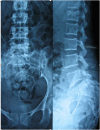Management of neglected sacral fracture with cauda equina syndrome: report of two cases with review of literature
- PMID: 28053722
- PMCID: PMC5129421
- DOI: 10.1038/scsandc.2015.20
Management of neglected sacral fracture with cauda equina syndrome: report of two cases with review of literature
Erratum in
-
Erratum: Management of neglected sacral fracture with cauda equina syndrome: report of two cases with review of literature.Spinal Cord Ser Cases. 2016 Jan 7;2:15028. doi: 10.1038/scsandc.2015.28. eCollection 2016. Spinal Cord Ser Cases. 2016. PMID: 28067337 Free PMC article.
-
Erratum for Spinal Cord Series and Cases content published prior to July 2016.Spinal Cord Ser Cases. 2016 Jul 21;2:16019. doi: 10.1038/scsandc.2016.19. eCollection 2016. Spinal Cord Ser Cases. 2016. PMID: 31265710 Free PMC article.
Abstract
Study design: A retrospective study was performed.
Objectives: To analyze the outcome of two neglected sacral fractures who presented late to us after 6 weeks of injury with main complaints of incontinence and numbness in sacral region. There are no guidelines for management of complex fractures of sacrum who present late, and available literature is equally perplexing.
Methods: Patients were evaluated and radiological investigations were done. Anterior-displaced U-shaped fracture was found to be present between S2 and S3 with bony fragments encroaching the canal. Decompression with wide sacral laminectomies was done without any fixation.
Results: Case 1 showed complete recovery of bladder and perineal sensations 6 months post surgery. Second patient (case 2) had partial recovery of bladder control but numbness persisted till last follow-up at 6 months.
Conclusion: Neglected fractures of sacrum that present later than 6 weeks post injury with cauda equina syndrome could be given a chance for decompression if imaging shows canal encroachment with bony fragments. Fixation of fracture may not be required in all unstable sacral fractures after 6 weeks.
Keywords: Physiology; Surgery.
Figures







References
-
- Routt ML Jr , Simonian PT , Swiontkowski MF . Stabilization of pelvic ring disruptions. Orthop Clin North Am 1997; 28: 369–388. - PubMed
-
- Vaccaro AR , Kim DH , Brodke DS , Harris M , Chapman JR , Schildhauer T et al. Diagnosis and management of sacral spine fractures. Instr Course Lect 2004; 53: 375–385. - PubMed
-
- Schmidek HH , Smith DA , Kristiansen TK . Sacral fractures. Neurosurgery 1984; 15: 735–746. - PubMed
-
- Sengupta DK . Neglected spinal injuries. Clin Orthop Relat Res 2005; 431: 93–103. - PubMed
-
- Rajasekaran S , Kamath V , Basu S , Gupta S . Neglected spinal trauma. In: Jain AK , Kumar S (eds). Neglected Musculoskeletal Injuries. 1st edn, Jaypee Brother Medical Publisher: Delhi, 2011, 142–159.
LinkOut - more resources
Full Text Sources
Other Literature Sources

